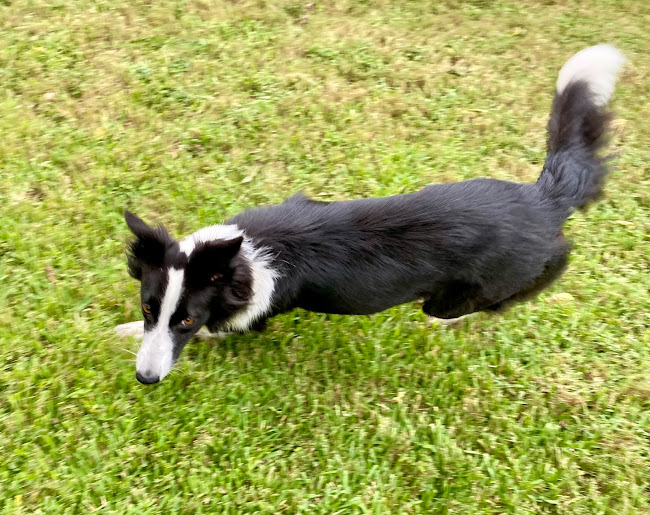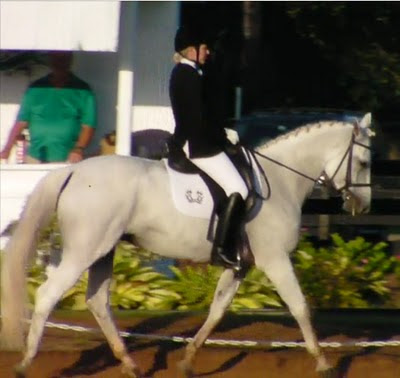Heh heh heh. Princess toes was cited on the "News From the Show Circuits" American Trakehner Association web page for her test under dressage judge General Burton at Windy Knoll Farm.
Check out the link by clicking here.
Sunday, October 24, 2010
The Trakehner Totilas sold to Paul Schockemohle
The Web site of the Trakehner Verband reports (October 15, 2010) that the dressage WEG triple-Gold Medal winner TOTILAS (by Gribaldi, out of a Dutch mare) has been sold to Paul Schockemöhle, former German Olympic jumper rider and top horse breeder and dealer, for an undisclosed price that is rumored to be in the double digit million Euro range. It is not clear whether Schockemöhle intends to compete the stallion or use him strictly for breeding.
Schockemöhle had also acquired Totilas' sire Gribaldi earlier this year but lost him when the stallion died unexpectedly due to a torn artery.
Schockemöhle had also acquired Totilas' sire Gribaldi earlier this year but lost him when the stallion died unexpectedly due to a torn artery.
Wednesday, October 20, 2010
Jeff Moore Clinic October 16-18 2010
Doesn't matter if she gazes at the sheep:
Jeff had this to say about Delphi:
Concerning raising the neck and keeping the horse light in the hands, we learned the following from Jeff Moore:
You can raise the neck with the reins in light fluffs or when necessary when the horse crashes down loading the hands with weight, with a firm heave-ho up standing in the stirrups (always followed by the critical release with hands back down in normal position). You can get the horse tall and ugly (above the bit) with the neck raised up out of the horse's comfort zone to create experimentation. When the horse is working correctly, the bottom of the horse's neck becomes concave and the neck topline becomes convex. Raise the horse even higher than its version of above the bit until it decides on its own to drop its snout and yield to the bit.
She IS allowed to drop her snout down, but NOT allowed to load the hand with weight. I'm correcting her for the terrible down pressings, but I'm NOT trying to force her head down. I'm just saying "If I keep you in this kind of icky place, would you care to try an experiment or two?" And she says "Okay, how 'bout down crash-- it's my best trick!" Eventually there is a tiny glimmer of putting the nose down without putting pounds and pounds into my hand.
I want her to raise her back up and find my butt, so I keep a slightly lighter seat to encourage her back to come up. When the nose drops, it should be just as light in my hand as when the neck is fluffed up in the air. She has to be easily raisable any time whether she stays on the bit or not, MUST stay light in the hand.
The way to get her to experiment: first tell her the down smashing is NOT okay, then she floats around unsure of anything, then I raise her above her comfort zone even if it's above the bit and ugly. It is LIGHT, and ALIGNED, and higher than she'd like to be. Then I wait for her to experiment: she'll get tired of this and bored with this and start to press down and I'll say "NOPE, that's not an experiment I can accept." By keeping her higher than her comfort zone she'll start to experiment in other ways that might make her life easier. If I allow her to go around with a low neck, she'll be perfectly comfortable for 20 years!
So keep her higher than her comfort zone and then experimenting is allowed but NOT down crashing. She can slowly learn that it's okay to lower the snout but not to load the hand, and NOT to lower the chest and back. Then bit by bit we come to an understanding when she figures out how to stay round without getting heavy. I'll stop keeping my hands high and put my hands back down to normal.
For Delphi, at the moment, turning only on a polygon (with straight lines after each turn) and counter-flexion will help keep her straighter and keep her shoulder from falling out in the so-called "bend" of the neck. Don't necessarily think "bend" rather think "straight."
On the lengthening on the diagonal, at X do a soft, lifty, puffy bringing the neck up and back up with a tall fluffy rein back so the horse anticipates the lengthening as a preparation for a fluffy up rein back. Also do a fluffly rein back at the end of the lengthening.
Try dainty fluffy lifts up first; if the horse crashes down you can stand in the stirrups and heave the horse up. It is okay if the horse tosses her head up. Keep the horse way up high and dainty until the horse decides on its own to drop its snout.
The horse can lower its neck as long as it is not leveraging down into the hand. You teach the horse when you flutter the reins and raise the horse the horse collects under you. The complexis muscles should be seen in front of the middle and widest part of the neck; be seen the entire length of the neck; and be vibrant and alive.
Wednesday, October 13, 2010
Sunday, October 10, 2010
Day 1 Cimetidine Treatment
The treatment regimen is five 800mg capsules twice daily for ten days, then five 800mg capsules daily for two months. I crush the tablets with a mortar and pestle and top dress her feed.
Time will tell if the cimetidine shrinks the melanoma.
Tuesday, October 5, 2010
Trakehners at the 2010 WEG
The following full and half-Trakehners competed in the 2010 Alltech FEI World Equestrian Games in Kentucky:
Dressage:
EXQUIS NADINE by E.H. Partout, out of Charites (KWPN), rider Hans Peter Minderhoud, The Netherlands – 10th after Grand Prix, 22nd after Grand Prix Special
HALBGOTT, approved stallion by E.H. Partout, out of Hatari by E.H. Consul, rider Marco Bernal, Colombia – 63rd after Grand Prix
MOORLAND’S TOTILAS by E.H. Gribaldi, out of a Dutch mare by Glendale (KWPN), Rider Edward Gal, The Netherlands – Individual Gold, Team Gold, Individual Gold in Freestyle
PRINS 32, Russian Trakehner, rider Susan de Klein, Netherlands Antilles – 39th after Grand Prix
SEDUC by Induc - Go On Then xx, rider Anne Troensegaard, Denmark – 47th after Grand Prix
Eventing:
JAKATA by Abdullah *Pg*E*, rider Piggy French, Great Britain – 24th after dressage, 12th after cross-country, 16th final
OPPOSITION BUZZ by Fleetwater Opposition, out of Jungle Bee xx by Java Tiger xx, rider Nicola Wilson, Great Britain – 42nd after dressage, 20th after cross-country, 15th final
OSTLER by Juror xx, out of Ostka by Jaskier, rider Lukasz Kazmierczak, Poland – 52nd after dressage, 54th after cross-country, 49th final
So, this moves Kobra von C and Kougar von C right to the top of the potential husband list for Delphi. Not that I'm looking, of course...
Dressage:
EXQUIS NADINE by E.H. Partout, out of Charites (KWPN), rider Hans Peter Minderhoud, The Netherlands – 10th after Grand Prix, 22nd after Grand Prix Special
HALBGOTT, approved stallion by E.H. Partout, out of Hatari by E.H. Consul, rider Marco Bernal, Colombia – 63rd after Grand Prix
MOORLAND’S TOTILAS by E.H. Gribaldi, out of a Dutch mare by Glendale (KWPN), Rider Edward Gal, The Netherlands – Individual Gold, Team Gold, Individual Gold in Freestyle
PRINS 32, Russian Trakehner, rider Susan de Klein, Netherlands Antilles – 39th after Grand Prix
SEDUC by Induc - Go On Then xx, rider Anne Troensegaard, Denmark – 47th after Grand Prix
Eventing:
JAKATA by Abdullah *Pg*E*, rider Piggy French, Great Britain – 24th after dressage, 12th after cross-country, 16th final
OPPOSITION BUZZ by Fleetwater Opposition, out of Jungle Bee xx by Java Tiger xx, rider Nicola Wilson, Great Britain – 42nd after dressage, 20th after cross-country, 15th final
OSTLER by Juror xx, out of Ostka by Jaskier, rider Lukasz Kazmierczak, Poland – 52nd after dressage, 54th after cross-country, 49th final
So, this moves Kobra von C and Kougar von C right to the top of the potential husband list for Delphi. Not that I'm looking, of course...
It's Always Something
In preparing to introduce Delphi to the double bridle, and as a useful training tool we are using a kimberwick bit on Delphi:
 Delphi goes wonderfully in the bit and I am learning to develop more feel. However, Delphi has an ~10 centimeter benign melanoma right under her chin:
Delphi goes wonderfully in the bit and I am learning to develop more feel. However, Delphi has an ~10 centimeter benign melanoma right under her chin:
 So when the kimberwick chain is not in action, it rests directly on the tumor:
So when the kimberwick chain is not in action, it rests directly on the tumor:
 Under her veterinarian's orders, we are starting Delphi on oral cimetidine to reduce or hopefully eliminate the melanoma. There is always the option of surgical removal, but I strongly hesitate to create a wound where there is otherwise nothing open. We'll see what happens on the cimetidine.
Under her veterinarian's orders, we are starting Delphi on oral cimetidine to reduce or hopefully eliminate the melanoma. There is always the option of surgical removal, but I strongly hesitate to create a wound where there is otherwise nothing open. We'll see what happens on the cimetidine.
Saturday, October 2, 2010
Photos from Windy Knoll
Friday, October 1, 2010
Ye Ole Kimberwick
 Our trainer has once again come through with another brilliant training aid. While a kimberwick bit is not legal for dressage competition, we are using it as a training tool.
Our trainer has once again come through with another brilliant training aid. While a kimberwick bit is not legal for dressage competition, we are using it as a training tool.Wikipedia defines the kimberwick as "a bit that offers the rider a slight curb effect and provides a bit more control than a snaffle."
We tried Delphi in a kimberwick this week. For my part, I like it. It allows me to take my focus off of constantly testing for throughness (by allowing me to keep Delphi more through with less effort) long enough to focus on things like my lower leg position or transitions without being distracted by the constant effort to keep Delphi relaxed.
When Delphi and I go back to our dearly beloved pattern of maul and pull, stiffen and yank, brace and tug (a pattern we've worked hard at these last five years), the kimberwick interupts the behavior-on both our parts-allowing me to feel how much more or less to half halt and release more clearly and allowing Delphi to self-reward and/or self-correct if she juts her head up in an effort to brace or get heavy. By interrupting the unwanted behavior and reinforcing the desired behavior, the kimberwick has become a good training tool for both Delphi and me.
Subscribe to:
Posts (Atom)



























